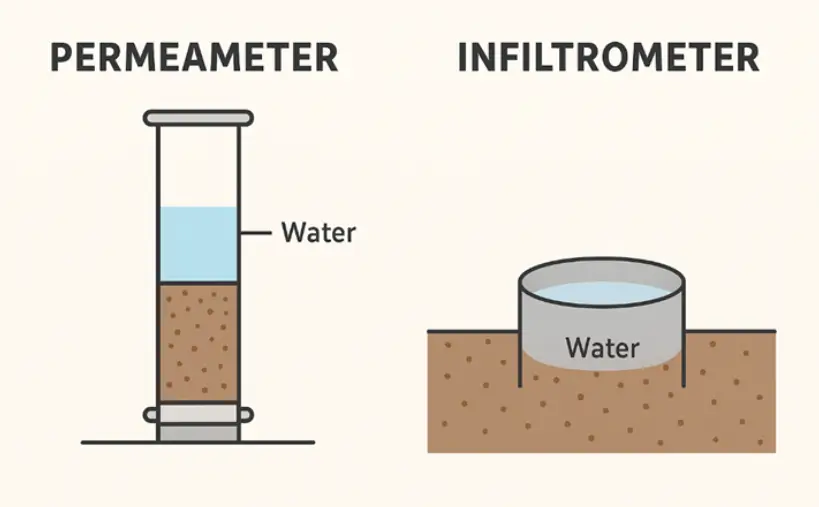Differences in Permeameters & Infiltrometers
A soil permeameter and infiltrometer are both essential instruments in soil science and hydrology for assessing the movement of water through soil. They share common features in measuring soil hydraulic properties, evaluating water flow, and are influenced by soil texture and structure. Both tools are widely utilized in fields such as agriculture, engineering, and environmental research to enhance understanding of water dynamics.
They are similar because they both study how water interacts with soil, specifically how it enters and moves through the soil, and both are critical for understanding water dynamics in natural and managed environments.
Permeameters measures permeability in a lab or controlled setup, often using soil cores. The permeameter measurement is how quickly water moves through soil (i.e. permeability or hydraulic conductivity) under saturated conditions, typically using a soil column in the lab or field. They focus on subsurface flow.
Infiltrometers measure how quickly water enters the soil surface (i.e. infiltration rate) under unsaturated to saturated conditions, usually in the field. Infiltration rate equals the change in water depth on surface divided by time. Time intervals measurements are typically every 5 to 10 minutes. They focus on surface water entry.

In short:
🔹 Permeameter = flow through soil
🔹 Infiltrometer = flow into soil
Permeameter and Infiltrometer Feature comparisons
| Feature | Permeameter | Infiltrometer |
|---|---|---|
| Measures focus | Permeability/Hydraulic Conductivity (Ksat) | Water Infiltration Rate |
| Water flow measurement | Through soil (subsurface) | Into soil (surface) |
| Used for infiltration rate | No | Yes |
| Soil Conditions | Saturated flow only | Saturated or unsaturated (e.g. with tension infiltrometer) |
| Soil type sensitivity | Lab samples or augured holes — more controlled | Highly sensitive to surface variability and crusting |
| Used for Ksat estimate | Yes | Not typically, except research-grade cases |
| Preferred environment | Laboratory, boreholes, or controlled field setup | Open field / in situ conditions (yards, golf courses, urban sites) |
| Setup | Soil column (lab or field) | Water applied on soil surface (field) |
| Measurement Output | cm/s or mm/hr (K) | mm/hr (infiltration rate) |
Permeameter and Infiltrometer Application Comparison
| Application / Scenario | Use a Permeameter | Use an Infiltrometer |
|---|---|---|
| Stormwater, infiltration, and low-impact development design | Sometimes | Yes |
| Agriculture irrigation planning | Sometimes | Yes |
| Subsurface flow modeling | Yes | No |
| Stormwater infiltration design | No | Yes |
| Foundation and embankment analysis | Yes | Sometimes |
| Erosion and runoff control | No | Yes |
| Groundwater recharge or pollution modeling | Yes | Sometimes |
| Soil health and compaction diagnosis | No | Yes |
| Leach field sizing and septic system design | Sometimes | Yes (esp. for percolation testing) |
Similarities of Permeameters and Infiltrometers
- Measure Water Movement in Soil:
Both are used to evaluate how easily water can move through soil—permeameters measure permeability (or hydraulic conductivity), and infiltrometers measure infiltration rate. - Assess Soil Hydraulic Properties:
They both help determine important hydraulic properties of soil, which are essential for irrigation planning, drainage design, and environmental assessments. - Depend on Soil Texture and Structure:
The measurements from both devices are influenced by the same soil characteristics—like texture (sand, silt, clay), compaction, organic matter, and structure. - Can Be Field or Lab-Based:
There are both field and laboratory versions of permeameters (e.g., constant head, falling head) and infiltrometers (e.g., single-ring, double-ring).
